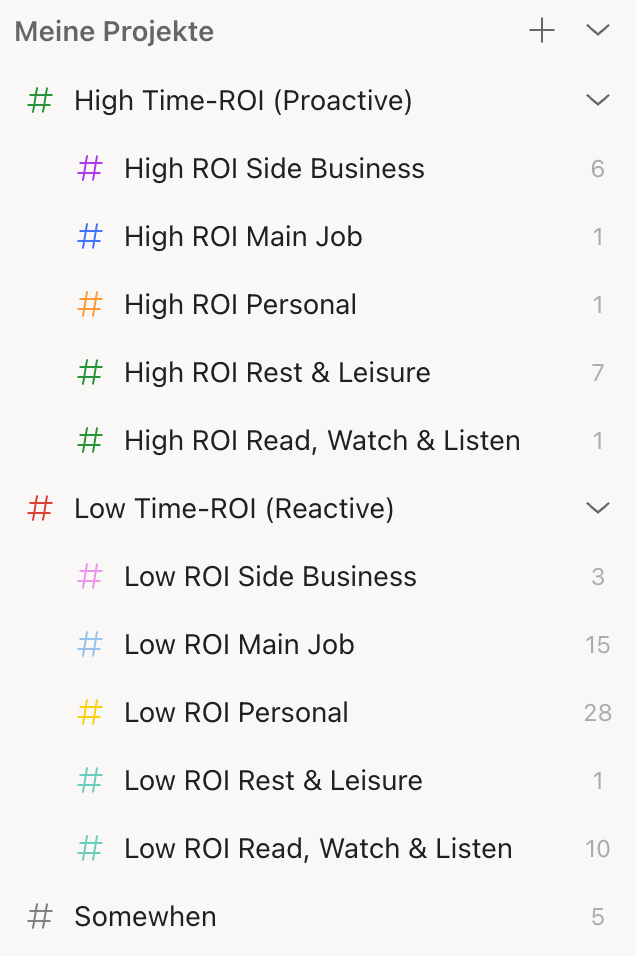Diligent Sunday #27: Prioritisation by Time ROI
Learn to master Time-ROI prioritization to reclaim your time and enhance productivity. This article guides you through auditing tasks, ranking them by time-saving potential and strategically focusing on high-value activities for a more efficient future.

"The key is not to prioritize what's on your schedule, but to schedule your priorities." – Stephen Covey
Introduction
Hello everyone,
Another week has passed, marking 92.2% completion of the year. Looking at the calendar, we're left with three work weeks; then one more week of hopefully relaxing with family and vacation.
My preparations for my 2023 annual review, clearing my Note & Tasks Management, and planning for 2024 are underway – activities I carry out in the final week of every year.
I'll delve into the how-to of yearly planning in my Christmas newsletter. However, I'd like to lay the groundwork today by introducing a prioritisation method you might not know: prioritising by Time-ROI.
"The bad news is time flies. The good news is you're the pilot." – Michael Altshuler
Determining what's important can be challenging. Many default to urgent issues arising from day-to-day chaos. Better off are those with an agenda of objectives for reference, enabling them to assess the progress each task brings.
But what if your agenda isn't that clear? Assessing the importance of tasks based on the freed-up future time they bring can be a good idea.
- You put effort into a task now to free up more time in the future.
- Investing time in delegation, for example, would score high on this scale.
Let's explore this Time-Return-on-Invest prioritisation method's Why, How, and What together.
Enjoy, and I wish you an excellent start to your week!
– Martin Weitzel


Unveiling the Benefits of Time-ROI in Prioritisation
In a world where the tick-tock of the clock reigns supreme, understanding the 'Why' behind Time-ROI can be transformative. Time Return on Investment (Time-ROI) is an innovative approach to prioritisation that goes beyond traditional urgency and importance matrices. It is an investment mindset applied to time management, where the currency is your minutes and hours instead of dollars and cents.
The principle behind Time-ROI is straightforward: prioritise tasks that yield the greatest return in terms of future time saved. By investing in these high Time-ROI activities, you're essentially buying yourself more time in the future. This could mean automating repetitive tasks, delegating responsibilities, or learning a new skill that makes you more efficient.
The benefits of this approach are manifold:
- Increased Efficiency: By focusing on tasks with the best Time-ROI, you streamline your workload, cutting down on wasted time and effort.
- Strategic Focus: It forces you to consider the long-term impact of your activities, aligning your daily actions with broader goals and visions.
- Stress Reduction: Knowing that you're investing in your future can reduce the anxiety associated with a never-ending to-do list (“it will get better, not worse”).
- Better Decision-Making: When you evaluate tasks through the lens of Time-ROI, it clarifies what's truly important, helping you say no to less impactful activities.
Emotionally speaking, particularly the most ambitious among us can often feel trapped in a hamster wheel of busyness, investing much effort without feeling progress. This quickly leads to overwhelm or even burnout.
Classifying tasks based on time-ROI quickly highlights the problem. Using this time-ROI mindset for decision-making helps us select tasks that aid in escaping the busyness hamster wheel and avoid those that offer no future relief.
"An investment in knowledge pays the best interest."
– Benjamin Franklin

Mastering the Method – Steps to Implement Time-ROI in Your Schedule
Adopting the Time-ROI strategy requires a shift in perspective and a methodical approach. Here's how you can master the method and start reaping the rewards of a time-rich schedule:
- Audit Your Current Activities: Take stock of where your time goes. Identify tasks that consume your time with little return.
- Rank Tasks by Potential Time Savings: Estimate how much future time each task might save you. This can be speculative but aim for educated guesses.
- Assess the Effort Required: Consider the effort and resources needed to complete each task. A high Time-ROI task should ideally require less effort for more future time savings.
- Prioritise: Arrange your tasks in order of their Time-ROI, starting with those that promise the most significant net gain in time.
- Execute and Reassess: Implement your prioritised tasks. Periodically reassess your activities to ensure they're still yielding the expected time savings.
High Time-ROI tasks are levers to create a more efficient and effective schedule. One that continuously evolves to serve your long-term objectives.
The first steps towards operationalising the Time-ROI method can be pretty simple, especially if you use a task management app that allows some folder structuring.
I currently use Todoist, where you can categorise projects into folders for better organization. I've designated tasks into two categories: Low Time-ROI and High Time-ROI.
The following image displays my projects on Todoist and my initial task allocation.

I was surprised to find most of my tasks were low-ROI, with none being high-ROI. This lack forced me to reflect on what high-return activities, like soothing leisure activities, meant to me. Prioritising by ROI, I then planned and executed top-notch leisure activities.
Despite adopting the ROI approach for two weeks now, the ratio is still unsatisfactory, with 57 low-ROI tasks compared to 16 high-ROI tasks.
This will be my baseline for progressively prioritising more high-ROI tasks each week.
"The best time to plant a tree was 20 years ago. The second best time is now." – Chinese Proverb

Practical Applications – Identifying High Time-ROI Tasks for Maximum Efficiency
Identifying tasks with a high Time-ROI can profoundly impact productivity and time management. These tasks typically fall into several categories:
- Automation: Any task you can automate saves you countless hours in the future. Whether it's email filtering, data entry, or social media posting, if it can be automated, it should be.
- Delegation: Pass on tasks to others if they can achieve 80% of your quality. Focus on tasks uniquely requiring your skills. Even though delegation demands time investment, persistent feedback and coaching eventually pay off. Don't hastily assume it's pointless just because you pass tasks without proper delegation.
- Saying No: You cannot determine essential tasks versus time-wasters in many roles. For example, your boss or the organisational system might impose tasks. A high-ROI task might involve investing time in influencing your boss or changing the system.
- Education: Learning a new skill or tool can seem time-consuming at first, but it can save you significant time in the future. This could be because you approach tasks and projects more intelligently or because your improved education leads you to a job or role where you can work more focused and independently.
- Systemisation: Build and implement systems for recurring duties to maintain standards and save time. Record these routines to enable easy repetition or delegation. For instance, if you have personal self-improvement goals, it's often a good strategy to convert these into daily activities as part of your morning routine. While it may take some time and energy initially, once the routine is established, you'll need hardly any willpower to sustain your desired changes.
- Preventative Measures: Spending time on preventative measures, like health and wellness activities or regular equipment maintenance, can prevent significant time loss due to unforeseen issues
Evaluating certain situations can be challenging. For example, I'm currently dedicating 1.25 hours daily to a task I call 'Personal Order.' This involves a desk session where I review and plan my notes, tasks, and calendar and write in my journal.
At times, this task seems like overhead with little payoff—is it procrastination? Yet, I could also view it as a task that instills order, enhancing my productivity throughout the day.
One approach would be to stop seeing my personal order routine in black-and-white terms, instead reviewing its content to ensure it only includes elements aiding my later effectiveness.
Hence, adopting a Time-ROI mindset can help better align and design tasks.
“Do not squander time, for that is the stuff life is made of."
– Benjamin Franklin

Time-ROI is A Strategic Approach to Reclaiming Our Most Valuable Asset
Wrapping up this Diligent Sunday, it's evident Time-ROI prioritisation isn't just a productivity tool, but a surefire way to regain control of our time. By comprehending the 'Why', mastering the 'How', and pin-pointing the 'What' of Time-ROI, we can streamline lengthy to-do lists into high-value tasks, promising a brighter, streamlined future.
Transitioning towards a high Time-ROI lifestyle means healthy effort investment and a mindset change. It involves auditing current activities, ranking our tasks based on time-saving potential, and prioritising strategically. Speaking from personal experience, the reward lies in uncovering and adjusting our daily efforts for tasks that offer significant time returns.
“Time is a created thing. To say 'I don't have time' is to say 'I don't want to'." – Lao Tzu
Ultimately, Time-ROI prioritisation isn't just about being busy but smartly managing active hours. It safeguards that each minute invested today shapes a more productive, less stressful tomorrow. It's a continuous process demanding vigilance and habitual realignment of activities to fit long-term goals.
As we approach the end of the year, let's reflect on our Time-ROI. Instead of simply doing more, let's focus on doing what genuinely matters. This gets us nearer to the challenging balance of productivity and peace—a balance that helps us achieve goals while savouring the journey there.
Thanks for exploring Time-ROI with me. Hopefully, it'll help you make strategic choices to improve your weeks, even your year. Until next time, remember to invest your time wisely and enjoy the benefits of well-prioritised life.
Best regards,
– Martin Weitzel
- Mail: martin@deliberate-diligence.com
- LinkedIn: https://www.linkedin.com/in/martin-weitzel/
"To achieve great things, two things are needed: a plan, and not quite enough time." – Leonard Bernstein

Discussion